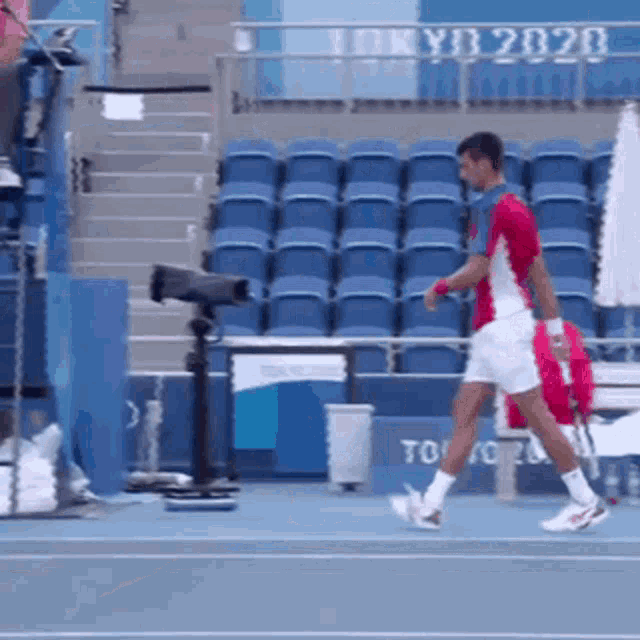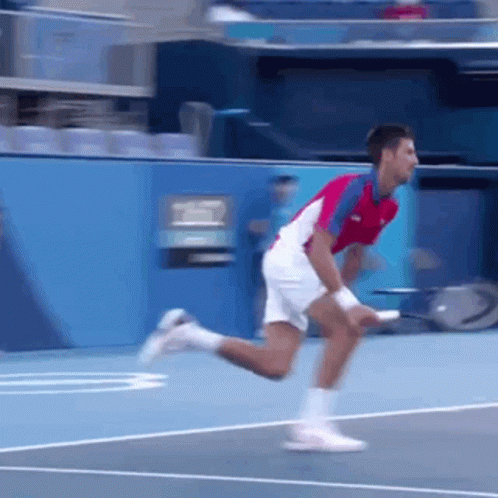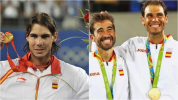- Joined
- Apr 14, 2013
- Messages
- 9,709
- Reactions
- 5,045
- Points
- 113
I wanted to approach the question of "GOAT" from a slightly different angle. As I've said in various threads, I tend to take a "multi-perspectival" approach: meaning, you can approach the question from different perspectives, and no single perspective is absolute right. For instance, we can take the "gun to head" perspective and pretend that the question has to be answered. And then we have to work out a system or way of ordering players, be it eyeball, performance results, advanced metrics, or some combination - and then figure out how to weigh it all together. It becomes exceedingly complicated when you take into account the different eras, talent levels, etc.
Or we can take a more blase approach, and not worry about such things and just consider greatness as an ever-changing thing...there are greats of the past, greats of the present, and will be greats of the future. To compare them, or try to rank them, is a fool's errand and ultimately impossible.
While I think the latter perspective may be true in an absolute sense, I do find it interesting to try to approach it from the first perspective: That if we have to rank and order them, what is the best way to do so? What criteria do we consider, what do we jettison, and how do we weigh it all? It doesn't need to be some kind of absolute determination or statement, but is just fun (for some) way of looking at and comparing tennis players.
But in this post, I'm going to take an approach more similar to the second perspective, and look at the Elo ratings of the Big Three - and how, in a sense, they show us that we can't compare them in a one-for-one sort of way. Let's take a look at a chart:

This chart illustrates why (among other factors) if I have to answer the first question, Novak Djokovic comes out on top: His absolute peak is just higher than that of Roger Federer and Rafael Nadal, both of whom are basically exactly the same (Roger's at 2550, Rafa's at 2552).
On the other hand, this chart also illustrates something we all know, but for whatever reason often seems lost in the discussion of their relative greatness: They peaked at different times. Elo isn't a perfect measurement, but it does a fairly good job at telling us when a player was at their best.
According to Elo, Roger peaked in March of 2007, after he won the Australian Open but before he went out early at Indian Wells and Miami - two tournaments he had won in both 2005 and 2006. But the end of 2007, while he still remained the top player on tour and it was one of the ten or so best seasons in Open Era history, his Elo dipped below 2500 permanently, thought he surpassed 2450 twice more: in 2012 and again in late 2017 to early 2018.
So Roger's absolute peak was in 2006 to 2007. He remained a great player for more than another decade, but his highest level was in 2006-07.
Rafa reached 2400 for the first time in 2006. To get a sense of what 2400 Elo means, it is about the average for the year-end #1 in Elo throughout the Open Era, and close to Pete Sampras' peak Elo of 2407. Meaning, a 2400 Elo means you're probably the best player on tour, or at least good enough to be the best at any given moment. Or to put it another way, by 2006, Rafa was about as good as Sampras was at his best - though swapping out clay dominance for grass dominance. We might see that as an indictment on Sampras, but I think that is largely due the fact that the level of the Big Three has skewed our historical memory of tennis greatness. Before the Big Three, only a handful of players had ever reached the 2500 Elo level during the Open Era: Rod Laver, Jimmy Connors, Bjorn Borg, John McEnroe, and Ivan Lendl. That's it. Andy Murray skimmed the edge, maxing out at 2500, so we're talking only nine players.
Anyhow, Rafa reached a new height in 2008, when he backed up his usual clay dominance with his first non-clay Slam at Wimbledon. But he didn't reach his absolute peak until 2013 to early 2014, after what was almost certainly his best year. Meaning, according to Elo, the very best version of Rafa was 2013, not 2010 or 2008.
Novak reached an elite level in 2007 ("elite" being roughly 2200 Elo, which is close to the Open Era #5 Elo average), but it wasn't until 2011 that he breached 2400 Elo, or #1 equivalent, and then rose to his absolute peak in late 2015 to early 2016.
So consider the times of their absolute peaks: March of 2007 for Roger, September of 2013 for Rafa, February of 2016 for Novak. Roger and Rafa were exactly five and a half years apart; Rafa and Novak were just under two and a half years apart.
Now this doesn't mean there wasn't some overlap, and certainly on a match basis, we've seen them all play each other at peak levels. But in terms of their overall career trajectories, their absolute peaks were at different times, in different contexts, and it is virtually impossible to align those peak levels and imagine how their greatness would have matched up, given a context-neutral situation.
One question that might arise is how much Elo relies upon other peak players. Meaning, would Roger's Elo in 2006 be lower if Rafa and Novak were in peak form? Absolutely, but probably not as much as you might think. In any given year, a player typically only plays another player a few times, so it only impacts Elo to a relatively small degree. And of course we have to consider specifics: Roger was 2-4 vs Rafa in 2006, probably his third worst year vs Rafa (after 2008 and 2013).
Certainly all three would have had different careers if they were exactly the same age and peaked at the same time. Although then, we might have seen even fewer non-Big Three big title wins. We start running into realms of speculation.
What we're left with is well-illustrated by the chart above: career "waves" of dominance that overlapped and intermixed, but different absolute peaks.
Addendum: When the Big Three Were Closest
As a side note, in the above chart, notice their convergence in 2012. For about half the year, they were neck and neck in Elo. Novak started the year on top, with Roger next, then Rafa just behind. Roger snuck ahead of Novak briefly in May, then back back and Rafa surged ahead of both during clay season, then Roger surged and was at the top for a few months until Novak passed him late in the season. You can see their path here:

So the closer they were all at was either before Roland Garros or during Wimbledon - the heart of the season.
The Big Three were relatively close in two periods: 2010-12 and 2017-19. Or at least those are the periods in which they were closest to each other in terms of Elo, and crossed "Elo paths" most frequently. Roger dominated up until that first period, Novak mostly dominated between the two periods, as well as after, and Rafa had his peaks throughout, and was the steadiest presence from 2005 on, the connective tissue between Roger's earlier peak and Novak's later one, separated by a decade. Another way in which their greatness flowed and manifested in different ways.
Or we can take a more blase approach, and not worry about such things and just consider greatness as an ever-changing thing...there are greats of the past, greats of the present, and will be greats of the future. To compare them, or try to rank them, is a fool's errand and ultimately impossible.
While I think the latter perspective may be true in an absolute sense, I do find it interesting to try to approach it from the first perspective: That if we have to rank and order them, what is the best way to do so? What criteria do we consider, what do we jettison, and how do we weigh it all? It doesn't need to be some kind of absolute determination or statement, but is just fun (for some) way of looking at and comparing tennis players.
But in this post, I'm going to take an approach more similar to the second perspective, and look at the Elo ratings of the Big Three - and how, in a sense, they show us that we can't compare them in a one-for-one sort of way. Let's take a look at a chart:
This chart illustrates why (among other factors) if I have to answer the first question, Novak Djokovic comes out on top: His absolute peak is just higher than that of Roger Federer and Rafael Nadal, both of whom are basically exactly the same (Roger's at 2550, Rafa's at 2552).
On the other hand, this chart also illustrates something we all know, but for whatever reason often seems lost in the discussion of their relative greatness: They peaked at different times. Elo isn't a perfect measurement, but it does a fairly good job at telling us when a player was at their best.
According to Elo, Roger peaked in March of 2007, after he won the Australian Open but before he went out early at Indian Wells and Miami - two tournaments he had won in both 2005 and 2006. But the end of 2007, while he still remained the top player on tour and it was one of the ten or so best seasons in Open Era history, his Elo dipped below 2500 permanently, thought he surpassed 2450 twice more: in 2012 and again in late 2017 to early 2018.
So Roger's absolute peak was in 2006 to 2007. He remained a great player for more than another decade, but his highest level was in 2006-07.
Rafa reached 2400 for the first time in 2006. To get a sense of what 2400 Elo means, it is about the average for the year-end #1 in Elo throughout the Open Era, and close to Pete Sampras' peak Elo of 2407. Meaning, a 2400 Elo means you're probably the best player on tour, or at least good enough to be the best at any given moment. Or to put it another way, by 2006, Rafa was about as good as Sampras was at his best - though swapping out clay dominance for grass dominance. We might see that as an indictment on Sampras, but I think that is largely due the fact that the level of the Big Three has skewed our historical memory of tennis greatness. Before the Big Three, only a handful of players had ever reached the 2500 Elo level during the Open Era: Rod Laver, Jimmy Connors, Bjorn Borg, John McEnroe, and Ivan Lendl. That's it. Andy Murray skimmed the edge, maxing out at 2500, so we're talking only nine players.
Anyhow, Rafa reached a new height in 2008, when he backed up his usual clay dominance with his first non-clay Slam at Wimbledon. But he didn't reach his absolute peak until 2013 to early 2014, after what was almost certainly his best year. Meaning, according to Elo, the very best version of Rafa was 2013, not 2010 or 2008.
Novak reached an elite level in 2007 ("elite" being roughly 2200 Elo, which is close to the Open Era #5 Elo average), but it wasn't until 2011 that he breached 2400 Elo, or #1 equivalent, and then rose to his absolute peak in late 2015 to early 2016.
So consider the times of their absolute peaks: March of 2007 for Roger, September of 2013 for Rafa, February of 2016 for Novak. Roger and Rafa were exactly five and a half years apart; Rafa and Novak were just under two and a half years apart.
Now this doesn't mean there wasn't some overlap, and certainly on a match basis, we've seen them all play each other at peak levels. But in terms of their overall career trajectories, their absolute peaks were at different times, in different contexts, and it is virtually impossible to align those peak levels and imagine how their greatness would have matched up, given a context-neutral situation.
One question that might arise is how much Elo relies upon other peak players. Meaning, would Roger's Elo in 2006 be lower if Rafa and Novak were in peak form? Absolutely, but probably not as much as you might think. In any given year, a player typically only plays another player a few times, so it only impacts Elo to a relatively small degree. And of course we have to consider specifics: Roger was 2-4 vs Rafa in 2006, probably his third worst year vs Rafa (after 2008 and 2013).
Certainly all three would have had different careers if they were exactly the same age and peaked at the same time. Although then, we might have seen even fewer non-Big Three big title wins. We start running into realms of speculation.
What we're left with is well-illustrated by the chart above: career "waves" of dominance that overlapped and intermixed, but different absolute peaks.
Addendum: When the Big Three Were Closest
As a side note, in the above chart, notice their convergence in 2012. For about half the year, they were neck and neck in Elo. Novak started the year on top, with Roger next, then Rafa just behind. Roger snuck ahead of Novak briefly in May, then back back and Rafa surged ahead of both during clay season, then Roger surged and was at the top for a few months until Novak passed him late in the season. You can see their path here:
So the closer they were all at was either before Roland Garros or during Wimbledon - the heart of the season.
The Big Three were relatively close in two periods: 2010-12 and 2017-19. Or at least those are the periods in which they were closest to each other in terms of Elo, and crossed "Elo paths" most frequently. Roger dominated up until that first period, Novak mostly dominated between the two periods, as well as after, and Rafa had his peaks throughout, and was the steadiest presence from 2005 on, the connective tissue between Roger's earlier peak and Novak's later one, separated by a decade. Another way in which their greatness flowed and manifested in different ways.


 And that's despite all editions being played on his best surfaces.
And that's despite all editions being played on his best surfaces. 






 )
)
